
Original Link: https://www.anandtech.com/show/2358
Introduction
Transcend has long been a player in the memory and storage arenas, both through the manufacture of hardware under their own brand name as well as OEM services for several other companies. Founded in 1989, the company has had a recent period of accelerated sales growth due to increased demand for its products, particularly in the flash memory segment (SD cards). As their success has grown, however, so has the number of competitors vying for their market share. With an eye to this, Transcend has been slowly expanding their portfolio of devices intended to replace the traditional hard disk. Their most recent entries have been 2.5" SSD disks, and we'll be focusing on their 16GB model that is designed for the industrial sector for this review.
Background
Solid state drives essentially replace the mechanical workings of a traditional hard drive (platters, spindle, motor, etc) with flash memory, resulting in incredibly fast seek times but - to date at least - slower overall transfer rates than mechanical disks. As solid state drives have no moving parts, their survivability in very harsh conditions, tolerance to shock, and noise output are all vastly superior to their mechanical counterparts. The fact that nearly all long-time computer users have had a hard drive failure in their lifetime leads many people to hope that a solution like SSD might someday replace mechanical hard drives as the storage medium of choice. SSD devices do, however, have several shortcomings.
- Cost: Solid state disks remain expensive, approaching $20 per Gigabyte in cost versus 40 cents per Gigabyte (less for desktop models) for conventional hard drives.
- Relatively Unproven Technology: Mechanical hard drives have been around for ages and their reliability levels are well known. Solid state disks are still relatively new, and their long term reliability has yet to be determined.
- Transfer Rates: While the highest-performing solid state disks are now boasting vastly improved transfer rates, most of these devices continue to lag far behind the conventional drives they seek to replace in terms of the speed at which they can transfer data.
Specifications
| Drive Specifications | |||
| MTRON SSD 32GB MSD-SATA6025 |
Seagate Momentus 7200.2 160GB ST9160823ASG |
Transcend 16GB TS16GSSD25-S |
|
| Manufacturer's Stated Capacity | 32 GB | 160 GB | 16GB |
| Operating System Stated Capacity | 30.9 GB | 149.05 GB | 15.5 GB |
| Interface | SATA 1.5Gb/s | SATA 3Gb/s | PATA - UDMA Mode 4 |
| Rotational Speed | n/a | 7,200 RPM | n/a |
| Cache Size | n/a | 8 MB | n/a |
| Read Seek Time | .1 ms | 14.1 ms | average 1 ms |
| Number of Heads | n/a | 4 | n/a |
| Number of Platters | n/a | 2 | n/a |
| Power Draw Idle / Load | .55W / 3.1W | .87W / 2.89W | .66W / 1.26W |
| Acoustics Idle / Load | 0 dB(A) / 0 dB(A) | 27 dB(A) / 33 dB(A) | 0 dB(A) / 0 dB(A) |
| Thermals Idle / Load | 29C / 31C | 33C / 39C | 27C / 28C |
| Write/Erase Endurance | >140 years at 50GB Write/Erase Cycles per Day | - | Transcend claims 3.6 million hour MTBF rating based on 10 year usage rates |
| Data Retention | 10 years | - | 10 years |
| Command Queuing | n/a | Native Command Queuing | n/a |
| Warranty | 5 Years | 5 Years | 2 Years |
Transcend's 2.5" SSD solid state disk line comes in three size offerings at this point in time, ranging from 8GB to 32GB. We'll be reviewing the middle product for this review, which weighs in at 16GB.
Transcend has chosen to offer two lines of 2.5" SSD drives, differing in their use of either IDE or SATA interfaces. This line in particular, which uses a 2.5" IDE interface, appears to be geared more toward notebook hard disk replacements in the industrial or medical fields. The 3,600,000 hour MTBF figure (common both to its SATA and IDE product lines) is extremely impressive under any circumstances, and certainly will make any notebook user who has experienced a conventional hard disk failure take note. However, given the impressive MTBF numbers, we are disappointed to see a two year warranty on the drive.
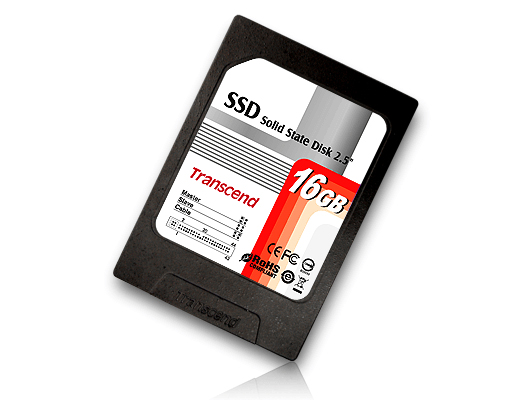
We'll put the SSD25 through its paces today, using the MTRON 32GB SSD, Super Talent 16GB SSD, and Seagate Momentus 7200.2 as comparison drives. We'll also include a Western Digital Raptor as a representative of what maximum performance desktop drives can achieve. While the SSD25 won't challenge the MTRON SSD or Western Digital Raptor drives in terms of raw performance, we feel it's important to showcase Transcend's offering against these drives to show both where the benefits - and weaknesses - of this alternative technology lie.
Test Setup
| Desktop Test Bed | |
| Processor | Intel E6600 - 2.4GHz 4MB Dual-Core |
| Motherboard | Gigabyte GA-P35-DQ6 |
| RAM | 2 x 1GB OCZ Reaper HPC PC2-6400 Settings: DDR2-800 @ 4-4-3-10 |
| OS Hard Drive | 1 x Western Digital WD1500 Raptor - 150GB |
| System Platform Drivers | Intel 8.3.0.1013 Intel Matrix RAID 7.6.0.1011 |
| Video Card | 1 x MSI 8800GTX |
| Video Drivers | NVIDIA ForceWare 162.18 |
| Optical Drive | Plextor PX-760A, Plextor PX-B900A |
| Cooling | Tuniq 120 |
| Power Supply | Corsair HX620W |
| Case | Cooler Master CM Stacker 830 |
| Operating System | Windows XP SP2 |
We are using an Intel E6600 dual core CPU to ensure we are not CPU limited in our testing. We've used a 2GB memory configuration for these tests, but will soon be updating our test beds to a consistent 4GB platform due to current DDR2-800 pricing and upcoming game and application requirements. Our choice of budget level OCZ Reaper HPC PC2-6400 memory offers a very wide range of memory settings with timings of 4-4-3-10 used for our storage benchmark results.
The MSI 8800GTX video card in our system ensures that our 1280x1024 resolutions are not GPU bound for our test results. Our video tests are run at 1280x1024 resolutions for this article at High Quality settings. All of our tests are run in an enclosed case with a dual optical/hard drive setup to reflect a moderately loaded system platform. The OS is fully updated and we load a clean drive image for each platform to keep driver conflicts to a minimum.
The test drive is formatted before each test run and five tests are completed on each drive in order to ensure consistency in the benchmark results. The high and low scores are removed with the remaining score representing our reported result. The Windows XP swap file is set to a static 2048MB and we clean the pre-fetch folder after each benchmark.
HD Tach and HD Tune
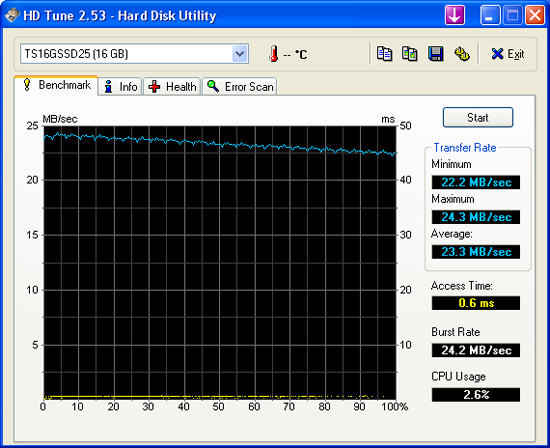 |
 |
HD Tach and HD Tune both show transfer rates typically in the 26-28MB/second range, which makes this unit appear to be slightly faster than the Super Talent SSD we reviewed earlier. We'll see if that holds true with actual applications tests, however, as HD Tach and HD Tune are purely synthetic in nature.
PCMark05 Performance
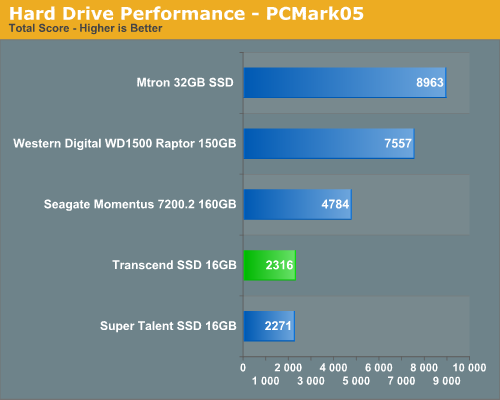
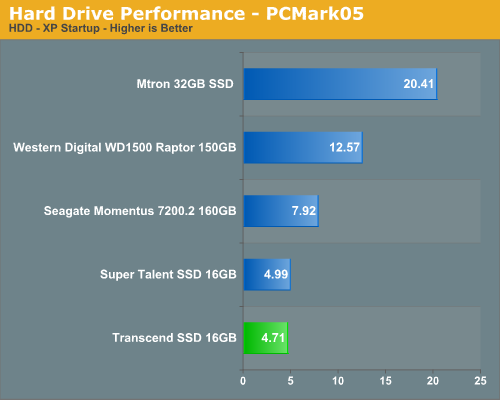
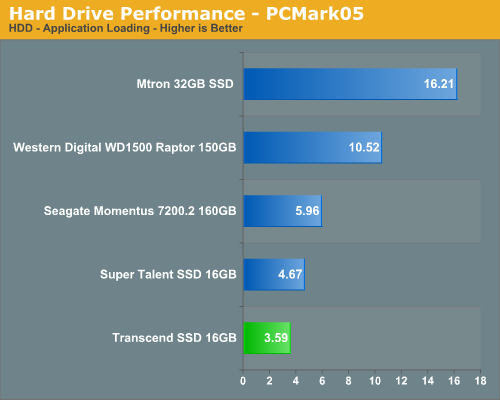
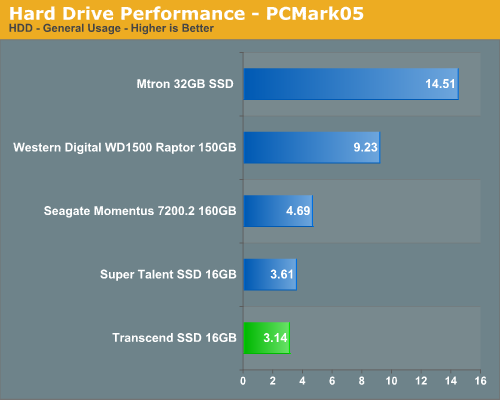
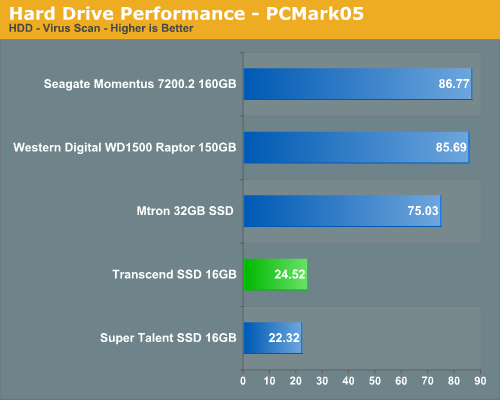
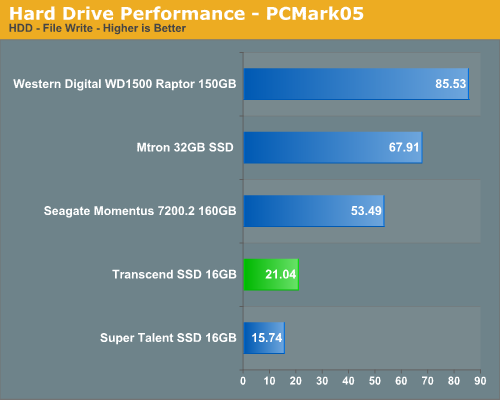
The Transcend SSD turns in performance levels comparable to the Super Talent which we previously reviewed, but far behind the zippier MTRON design. Of interest, while the Transcend SSD performs slightly slower in most read tests, it easily outclasses the Super Talent card when it comes to write performance. The difference in write performance is so great that it skews the PCMark total score in favor of the Transcend card, even though the Super Talent SSD came out on top in the majority of the tests.
Nero Recode
Our encoding test is quite easy - we take our original Office Space DVD and use AnyDVD Ripper to copy the full DVD to the hard drive without compression, thus providing an almost exact duplicate of the DVD. We then fire up Nero Recode 2, select our Office Space copy on the hard drive, and perform a shrink operation to allow the entire movie along with extras to fit on a single 4.5GB DVD disc. We leave all options on their defaults except we turn off the advanced analysis option. The scores reported include the full encoding process and are represented in seconds, with lower numbers indicating better performance.
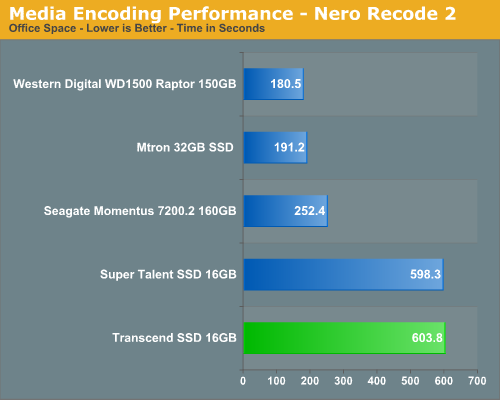
This test is dependent on CPU performance and the write performance of the drive. Unlike our PCMark05 test results, the performance of the Transcend drive is relatively poor in this test, resulting in a benchmark time that is a little over four times slower than our fastest drives. However, it does finish the test without any issues. This test is usually write intensive, but apparently the nature of the drive accesses is such that the Transcend falls behind the Super Talent; most of the other write-centric tests favor the Transcend drive.
File Copy Performance
Our file copy test measures the time it takes to transfer our test folder that contains 29 files, 1 folder, and has 7.55GB of data from our source drive to the target test drive. This benchmark is disk write intensive and requires a fast storage system.

Highlighting the relatively strong constant write performance of the Transcend SSD device, the test folder copied more than a minute faster than on the competition from Super Talent. Clearly, however, the Transcend is not a match for the conventional drives, nor can it compete with the MTRON SSD - the fastest SSD device we've tested in our labs to date.
WinRAR 3.70
Our WinRAR test measures the time it takes to compress our test folder that contains 444 files, 10 folders, and 602MB of data from our source WD Raptor drive to the target drive. While this test is somewhat dependent on write speeds, other components (i.e. the CPU) are a far greater factor in this test.

This test relies much more on the CPU but burst rates of the storage system are very important in order to keep up with constant data writes. Even handicapped with 23~24 MB/sec write speed, the Transcend drive is only about 7% slower than the MTRON or Raptor drives.
Supreme Commander
Our Supreme Commander test measures the time it takes to load the first campaign level. Our application timer begins when the launch icon is initiated and ends when the commander is visible and stationary on the ground.
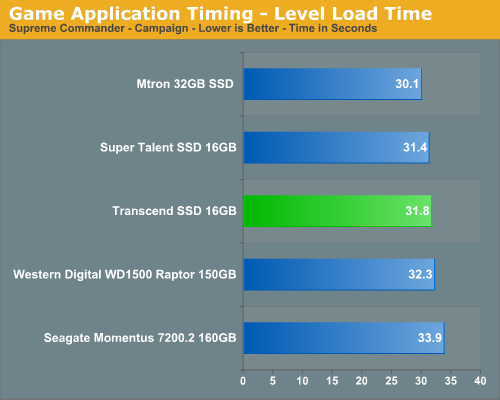
Supreme Commander's test plays to the strengths of SSD devices: the large number of smaller files required to start the first campaign level means that the lower access times associated with flash memory carry the day. In this benchmark, both the Transcend and the Super Talent SSD devices edge out the Seagate and WD drives - not that the 2-3 second performance advantage is all that significant, considering the price.
Operating System Performance
The following tests are designed to test a drive's ability to load and shutdown Windows XP along with entering and resuming from hibernation. We will have further test results under Windows Vista with the consumer level SSD products in our next review.
Windows XP Startup and Shutdown
These tests are fairly straightforward with our application timer measuring the time it takes to startup Windows XP from the splash screen until the desktop is visible (BIOS POST times are not included) and the time it takes to shutdown the operating system once the shutdown icon is initiated. We leave Excel and Photoshop Elements open with test files for the shutdown procedure.
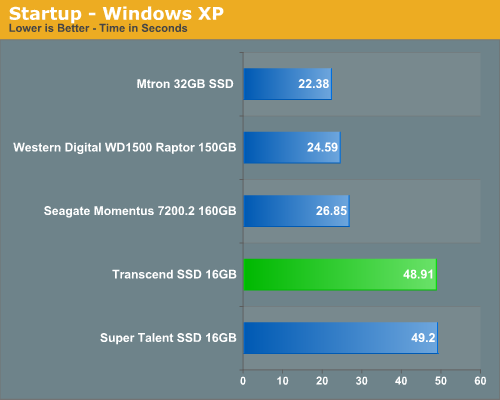
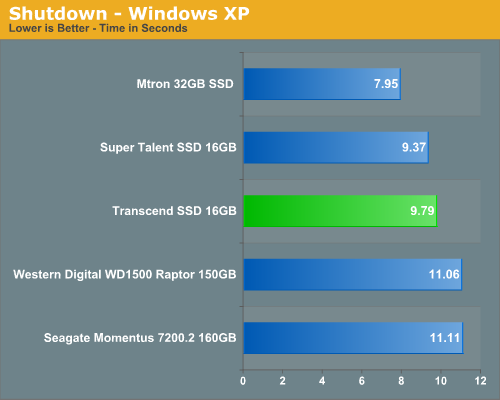
This test is dependent on read speeds for the startup section and we see the effects of the read speeds being capped on either the Transcend or Super Talent drive with it taking twice as long to startup when compared to the hard disks. In our shutdown tests, the SSD unit is about 16% faster thanks to its low latency times and data storage method.
Windows XP Hibernate and Resume
Our Hibernate test measures the time it takes for Windows XP to enter hibernation with Excel and Photoshop Elements open with a large spreadsheet and several test images open. The Resume test measures the time it takes for the system to return to the desktop once resume is initiated.


Our Transcend SSD unit is able to enter hibernation 27% faster and resume 26% faster than the mechanical drives. With the advantages of low latencies and always on capability after standby on SSD drives, we expected these results when entering hibernation mode. However, based on our previous XP startup results we did not expect the resume results to be quite this good with our Transcend drive. Our expectations were not based on SSD technology but the specifications of our particular drive. The resume results indicate the advantages of the SSD design in not having a mechanical spin-up and seek process along with improved access times in locating files.
Conclusion
Transcend's TS16GSSD25-S is a very solid offering for its intended market, coming in at performance and price levels similar to what we'd expect from the mainstream generation of SSD cards. While the MTRON drive soundly trounces the Transcend in all tests, there's no comparison between the two devices in the marketplace - the MTRON commands a price of over $1000, which is roughly three times more expensive than either the Transcend or the Super Talent.
As we can see from the overall benchmark scores, the appeal of SSD as a replacement for conventional hard drives is still a mixed bag depending upon your application. The SSD devices in this particular market sector simply cannot produce the throughput of a modern conventional hard drive, and this keeps it marginalized in most situations. Access times are much better, but overall performance typically favors conventional drives.
The capacity of the unit further limits its appeal - where a large capacity SSD device would seem to be a natural choice for most HTPC or desktop replacement situations based on the strength of its silent and cool operation, 16GB is far too small for any serious home theater user or for most SOHO type designs where a premium is placed on digital content. 32GB (which is the largest SSD in the Transcend product line) may be enough for limited use in these situations; however, we need to keep in mind this product was designed for a different purpose.
Desktop performance is not the real purpose of the Transcend SSD - or notebook performance for the most part, unless the performance happens to involve battery life, temperatures, durability, and/or noise levels. We can't accurately determine how well the current SSDs will hold up over the next few years, but at the very least a drive head crash or bearing failure is no longer going to be a concern. With claims of 10 year MTBF rates, the Transcend drive certainly looks to be more reliable. What we'd really like to see is a warranty to back that up - and considering the price and reliability claims, some provision for data recovery on any failed drives would go a long way toward making the drive more attractive. As it stands, we have lofty claims accompanied by a short two year warranty, and for the price you could purchase several identical conventional drives and set up a backup routine that would provide better long-term data retention.
The Transcend SSD card offers decent write performance, though its read speed trails the Super Talent SSD in all tests. With this in mind, and given the comparable street prices of the two devices, the ideal choice for some users may not be the Transcend TS16GSSD25-S but instead the Super Talent drive, though both serve their purpose well depending upon the configuration utilized. Given Transcend's history and traditional position as one of the leaders in the flash memory business, however, we look forward to Transcend's next generation offerings to see how those devices fare. With further price drops and improved capacities, it seems likely that SSDs will eventually reach the point where they can begin to overtake most conventional drives.







